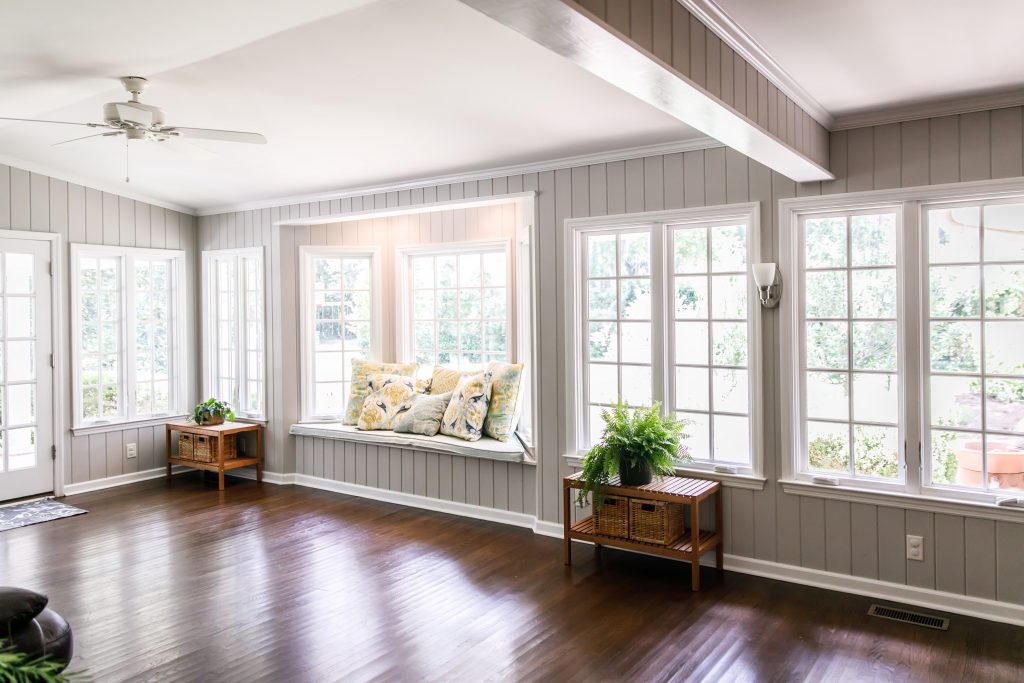
Thinking about a sunroom? Start with Wisconsin’s weather and your goals
If you live in southeast Wisconsin, you know our seasons can be breathtaking and unpredictable. That is why many homeowners weigh the benefits of a three-season or four-season sunroom to add light, space, and comfort. This guide explains 3 season vs 4 season room design in Wisconsin, focusing on structure, glass, and HVAC that stand up to our climate. With insights from Elite Improvements, a Burlington-based, family-owned remodeling and additions company, you will learn how to choose the right room for your home, lifestyle, and budget.
What is a three-season room?
Definition and best uses
A three-season room is designed for spring, summer, and fall. It offers protection from bugs and rain and extends outdoor enjoyment into the shoulder seasons. It is not intended for full-time winter heating. Many homeowners use three-season rooms for casual dining, morning coffee, or entertaining without the wind and mosquitoes. In Wisconsin, a well-built three-season sunroom can stay comfortable from April through October, depending on your insulation, glass choice, and personal comfort level.
Structure that holds up in Wisconsin
Even though a three-season room does not need the same insulation as a four-season space, it still must be built to handle wind, snow, and temperature swings. Elite Improvements focuses on structural details that add long-term durability.
- Foundation options: Piers, helical piles, or a slab-on-grade system can work. Proper frost-depth support and drainage are critical to prevent heaving and movement.
- Framing: Pressure-treated sill plates, quality studs, and corrosion-resistant fasteners reduce rot and rust. Properly sized headers and posts manage snow loads on large openings.
- Roofing: Tie into the home’s roof with an approved flashing method, or use a structurally rated patio roof with snow-load engineering. Asphalt shingles or standing seam metal are common for longevity.
- Flooring: Composite decking, tile over a stable substrate, or sealed concrete are easy to maintain and resist moisture in a three-season setting.
- Air sealing where it matters: Even if you are not fully insulating, targeted air sealing at the roof-wall connection helps keep out drafts and pests.
Glass choices for three-season rooms
Glazing determines comfort and durability. For a three-season room, you can blend screens with glass panels to fine-tune airflow and warmth.
- Tempered safety glass: Required near doors and low to the floor for safety. It is more impact resistant and safer than standard glass.
- Double-pane Low-E glass: Balances clarity with improved insulation. Look for U-factors around the mid 0.20s to low 0.30s for solid performance without the cost of triple-pane.
- Solar control: South- and west-facing walls benefit from solar control Low-E coatings to reduce heat gain in summer.
- Warm-edge spacers: These reduce condensation at the glass edge and improve longevity.
HVAC and electrical for three-season rooms
By definition, a three-season room is not conditioned like the rest of your home. That said, you can add comfort features that extend your usable days.
- Ceiling fans: Improve air movement and reduce perceived heat on warm days.
- Electric fireplace or space heater: Nice for chilly fall days. Use only as allowed by local code and never as the primary heat source.
- Portable or through-wall AC: Keeps summer temperatures comfortable without modifying your main HVAC system.
- Dehumidification: Helpful during humid months to reduce condensation on glass.
What is a four-season room?
Definition and year-round comfort
A four-season room, often called an all-season room, is fully insulated, air sealed, and heated and cooled for comfort 365 days a year. It functions like a conventional addition with more glass and light. In Wisconsin, that means meeting structural requirements for snow and wind, designing for condensation control, and choosing a robust HVAC plan. Elite Improvements builds four-season rooms that integrate smoothly with your home’s envelope, finishes, and systems.
Structure built for long winters
A four-season sunroom is a full-fledged addition. Even small structural shortcuts lead to drafty winters, condensation, or movement that damages finishes. The details below protect your investment.
- Foundation: Frost-depth footings, a full foundation, or engineered helical piers sized for loads and soils. Proper drainage and vapor barriers are essential.
- Framing and insulation: Advanced framing with continuous exterior insulation or well-packed cavity insulation in walls. Air sealing at every penetration protects against heat loss.
- Roof system: Engineered trusses or rafters rated for local snow loads. Proper ventilation or a conditioned roof assembly to prevent ice dams.
- Thermal breaks: At the slab, sill, and headers to prevent cold spots and condensation.
- High-quality flashing: Integrations at roof-wall and window openings that keep water out over decades.
Glass choices for four-season rooms
Windows and doors are the heart of a four-season sunroom. In Wisconsin, they must balance insulation, solar control, and light.
- Triple-pane Low-E glass: Often preferred for comfort and energy savings, with U-factors commonly ranging from the high 0.10s to low 0.20s.
- Double-pane Low-E as a value option: Can still work well with proper wall and roof insulation.
- Gas fill and spacers: Argon-filled units with warm-edge spacers lower condensation risk and improve performance.
- Laminated or tempered safety glass: Boosts safety and sound control, especially in large panels or near floor level.
- Orientation-specific coatings: Higher solar gain on the south can help passive winter warmth. Lower solar gain on west exposures helps prevent overheating.
HVAC choices that last through Wisconsin winters
Plan your HVAC for comfort, efficiency, and durability. The right choice depends on whether you tie into existing ductwork or prefer a separate system.
- Cold-climate ductless mini-split: Efficient heating and cooling in one unit, with models that perform in subzero temperatures. Great for sunrooms with lots of glass.
- Ducted tie-in: Works if your current furnace and AC have capacity and duct runs can be added without pressure issues.
- In-floor radiant heat: A premium comfort upgrade that keeps bare feet warm and reduces drafts along glass walls.
- ERV or HRV ventilation: Brings in fresh air while managing heat and humidity. Helps prevent condensation on glass during winter.
- Smart controls: Zoning, programmable thermostats, and humidity control protect finishes and maintain comfort.
3 season vs 4 season room: key differences that impact comfort, cost, and durability
When comparing a 3 season vs 4 season room in Wisconsin, think beyond the calendar. Consider how the room will feel on a humid July afternoon, a windy October evening, and a bright January morning. Then weigh the benefits against your budget and long-term plans.
- Comfort range: A three-season room shines from spring through fall, with fans and space heaters to stretch the shoulder seasons. A four-season room is designed for year-round use, staying warm in winter and cool in summer.
- Structure and insulation: Three-season structures can be simpler but still must meet snow and wind loads. Four-season rooms require robust foundations, full insulation, and meticulous air sealing.
- Glass performance: Three-season rooms often use double-pane Low-E. Four-season rooms lean toward higher-performance double- or triple-pane units, especially on large walls of glass.
- HVAC approach: Three-season rooms typically avoid permanent heating and cooling systems. Four-season rooms use integrated systems like mini-splits, ducted connections, or radiant floors.
- Energy costs: Four-season rooms cost more upfront but deliver controlled comfort and lower operating costs per degree of comfort. Three-season rooms cost less initially but cannot deliver reliable winter comfort.
- Maintenance: Both need quality flashing and sealing. Four-season rooms tend to have fewer condensation issues if designed correctly, thanks to better insulation and humidity control.
- Permitting and code: Both require permits. Four-season rooms must meet energy code standards, including insulation and window performance requirements.
- Resale and ROI: Four-season additions often add more appraised value because they count as conditioned living space. Three-season rooms still add appeal and lifestyle value at a lower upfront cost.
Durability in Wisconsin: what really makes a sunroom last
Moisture management
Water management is non-negotiable. Elite Improvements uses layered defenses to keep water out and let incidental moisture dry safely.
- Continuous flashing at roof and wall intersections with shingle-style overlaps.
- Sill pan flashing under doors and full-perimeter window flashing that ties into the water-resistive barrier.
- Gutters and downspouts sized for intense rain and snowmelt, with downspout extensions away from the foundation.
- Proper slopes on patios and grade to direct water away from the structure.
Thermal performance and condensation control
Condensation forms when warm, moist air meets cold surfaces. In Wisconsin, that often shows up on glass and at thermal bridges. Use higher-performance glass, continuous insulation, and air sealing to keep interior surfaces warmer. Pair that with controlled humidity, typically 30 to 40 percent in winter, to reduce the risk of fogging or water droplets on windows. Quality warm-edge spacers and careful installation around frames make a noticeable difference.
Wind, snow loads, and ice dams
Our region demands roof systems designed for snow, wind, and freeze-thaw cycles. Elite Improvements specifies appropriate roof pitches, ventilation or conditioned roof assemblies to limit ice dams, and fastening schedules that meet or exceed code. Proper attic air sealing and insulation over the sunroom can dramatically reduce heat loss that contributes to ice dam formation on roof edges.
Budget, value, and what drives cost
Cost depends on design complexity, foundation type, glass area, finishes, and HVAC. A three-season space generally costs less due to simpler structure and systems. A four-season room requires a foundation, higher-performance envelope, and HVAC, which increases investment. Elite Improvements helps you balance must-haves and nice-to-haves without sacrificing durability.
- Major cost drivers: Foundation type, window and door performance, roofing tie-ins, HVAC selection, and finish choices.
- Smart savings: Right-size the glass, use orientation-specific coatings, and consider a mini-split for efficient heating and cooling of a four-season space.
- Long-term value: Four-season rooms can contribute more to appraised living area. Three-season rooms deliver a strong lifestyle boost at a lower initial cost.
Permits, codes, and inspections in southeast Wisconsin
Both three-season and four-season sunrooms need permits and inspections. Local building departments verify foundation design, structural loads, safety glazing, and electrical. For four-season rooms, energy code requirements apply to insulation, air sealing, and window performance. Elite Improvements manages your permits and coordinates inspections to keep the project on schedule.
- Common requirements: Safety glass near doors and low sills, guardrails at raised floors, GFCI and AFCI protection for outlets, and smoke or CO detector integration where required.
- Energy considerations: U-factor and SHGC requirements for windows and doors, R-values for walls and roofs, and blower door testing in some jurisdictions for larger additions.
- Local guidance: Our team knows the expectations in Burlington and across southeast Wisconsin, reducing delays and rework.
How to choose: a simple framework for decision-making
- Clarify your purpose: Daily living space year-round or a breezy retreat for spring through fall?
- Set a comfort target: Are you okay with a sweater in October or do you want January mornings to feel like the family room?
- Define your budget range: Discuss realistic costs and priorities with a reputable contractor.
- Assess your site: Orientation, views, privacy, and how the roof will tie in are big factors.
- Decide on HVAC: Separate mini-split, tie into existing ducts, or seasonal comfort only.
- Pick your glazing strategy: South and west exposures may need solar control Low-E to prevent overheating, while north exposures benefit from higher insulation values.
- Plan for durability: Demand proper flashing, air sealing, and insulation details that stand up to Wisconsin’s climate.
- Work with a pro: Choose an experienced, accredited contractor who will guide design, permitting, and construction.
Why homeowners choose Elite Improvements
Elite Improvements is a family-owned remodeling and home additions company based in Burlington, Wisconsin. We serve southeast Wisconsin with a focus on craftsmanship, clear communication, and customer satisfaction. Whether you need a three-season retreat or a four-season living space, our team designs and builds rooms that look beautiful and perform in Wisconsin’s weather.
- Expertise across services: Remodeling, additions, roofs, siding, and custom decks let us integrate your sunroom with your whole home.
- Accreditations: BBB accredited and a member of Milwaukee NARI, we are committed to ethical practices and industry standards.
- Local experience: We understand local codes, permitting, snow loads, and the best glass and HVAC choices for our climate.
- Responsive service: From first call to final walkthrough, you get a dedicated team and regular updates.
Our process for three-season and four-season rooms
- Initial consultation: Discuss goals, budget, and how you plan to use the space. We evaluate orientation, tie-ins, and layout ideas.
- Design and selections: Floor plan, glazing strategy, roof style, and finishes. We recommend structure, glass, and HVAC for durability.
- Engineering and permits: We prepare plans, secure permits, and schedule inspections with your local authority.
- Build phase: Foundations, framing, roofing, windows, doors, electrical, insulation, HVAC, and finishes executed to high standards.
- Quality checks: We verify flashing, air sealing, and system performance to prevent future issues.
- Final walkthrough: We review maintenance tips and warranty details, then hand off a room you can enjoy immediately.
FAQs about 3 season vs 4 season room in Wisconsin
- Can I convert a three-season room into a four-season room later? Sometimes, but not always. It depends on the foundation, framing, and whether the space can be insulated and air sealed to meet code. Planning for a future upgrade can save time and money.
- Will a four-season room be too hot in summer? With proper Low-E glass, shading, and either a ducted tie-in or mini-split, a four-season room can stay comfortably cool even on hot days.
- What about condensation on windows in winter? High-performance glazing, warm-edge spacers, good insulation, and controlled indoor humidity reduce condensation. An ERV and proper ventilation help, too.
- Do I need triple-pane windows? Not always. Double-pane Low-E can work well, especially in three-season rooms. Many four-season rooms benefit from triple-pane in large window walls for comfort and efficiency.
- How long does construction take? Most sunrooms and additions take several weeks to a few months depending on scope, weather, and permitting timelines. Elite Improvements provides a detailed schedule before we start.
- Are there rebates for energy-efficient upgrades? Programs change, but you may find incentives for high-performance windows or heat pumps through regional programs. Check Wisconsin’s Focus on Energy for current offerings.
- What maintenance is required? Keep gutters clear, inspect caulking, and clean weep holes on windows. Schedule periodic HVAC service for four-season rooms to maintain efficiency and comfort.
Is a three-season or four-season room right for you?
If you want a budget-friendly space for breezy spring mornings and late-summer evenings, a three-season room is a great fit. If you want light-filled comfort in January and dependable cooling in July, a four-season room is the better choice. In either case, the key is building for Wisconsin: solid structure, smart glass, and HVAC that performs. Elite Improvements will help you weigh options and make informed decisions so you love your sunroom for years to come.
Ready to plan your sunroom? Talk with Elite Improvements
Elite Improvements designs and builds three-season and four-season rooms that look great and last. We serve Burlington, Milwaukee, and communities across southeast Wisconsin. Call 262-716-6663 or visit eliteimproves.com to schedule a consultation. Our team will help you compare 3 season vs 4 season room options, select the right structure, glass, and HVAC, and deliver a space that fits your home, your routine, and your budget.
Services available from Elite Improvements include full-service remodeling, home additions, and exterior improvements like roofing, siding, and custom decks. We are BBB accredited, part of Milwaukee NARI, and committed to ethical practices and exceptional service. Let’s bring more light and comfort into your home with a sunroom built for Wisconsin.





